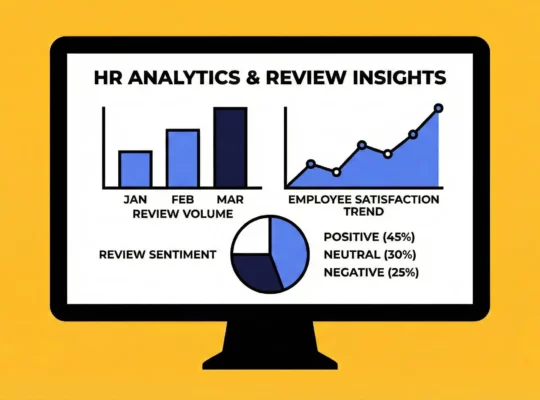Nowadays, both employer branding and corporate branding have become increasingly important for organizations looking to attract top talent and customers. While these two concepts share some similarities, they also have distinct differences that are crucial to understand. In this article, we’ll explore the key differences between employer brand and corporate brand, and how you can leverage both to build a strong, cohesive brand identity with the help of review.jobs, a certified employee review management platform.
What Are Some Key Differences Between Employer Brand and Corporate Brand?
Target Audience
An employer brand primarily focuses on attracting and retaining current and potential employees. It showcases the company’s culture, values, and employee experience to position the organization as a desirable place to work. A corporate brand, on the other hand, targets customers, investors, and the general public. It aims to build a positive reputation around the company’s products, services, and overall market position.
Focus
An employer brand emphasizes the company culture, values, employee experience, and Employer Value Proposition (EVP). It highlights what makes the organization unique as an employer and why talented individuals should consider joining the team. A corporate brand focuses on the company’s products or services, market position, and overall brand image. It communicates the organization’s mission, vision, and values to external stakeholders.
Communication Channels
Employer branding efforts are typically showcased through career pages, social media, employee testimonials, and internal communication platforms. These channels help to share the company’s story and attract potential candidates. Corporate branding relies on advertising, public relations, marketing campaigns, the company website, and press releases to reach its target audience and shape public perception.
Internal vs. External
An employer brand is primarily focused on shaping the internal perception of the company as a great place to work. It aims to engage and retain current employees while attracting new talent. A corporate brand is more externally focused, aiming to shape the perception of the company in the market. It seeks to build brand recognition, trust, and loyalty among customers and other external stakeholders.
Storytelling
Employer branding often involves sharing stories about employee experiences, company culture, and career development opportunities. These narratives help to humanize the brand and create an emotional connection with potential candidates. Corporate branding communicates the company’s mission, vision, values, and impact on the world. It tells the story of the organization’s purpose and how it creates value for its customers and society as a whole.
What is The Impact of Employer Branding and Corporate Branding?
The following table summarizes the impact of employer branding and corporate branding:
| Aspect | Employer Branding | Corporate Branding |
| Talent Attraction | Attracts and retains top talent by showcasing the company as an attractive place to work | – |
| Hiring Costs | Reduces hiring costs and time-to-fill positions by attracting higher quality candidates | – |
| Employee Engagement | Improves employee engagement, motivation, and productivity | – |
| Brand Awareness | – | Increases brand awareness and recognition in the market |
| Customer Loyalty | – | Builds customer trust and loyalty by communicating the company’s values and commitment to quality |
| Sales and Market Share | – | Drives sales and market share by making the company’s products or services more attractive to potential customers |
| Brand Value | Builds a positive reputation in the market, making the company more attractive to potential partners, investors, and customers | Enhances brand value and reputation, making the company more attractive to investors and potential partners |
The Convergence of Employer Brand and Corporate Brand
In the digital age, the lines between employer branding and corporate branding are becoming increasingly blurred. Social media, employee activism, and a growing demand for transparency have led to a convergence of the two concepts. Employees are now powerful brand ambassadors, and their experiences and opinions can significantly shape both the employer and corporate brand.
Employee-generated content has emerged as a powerful tool for both types of branding. Authentic stories and testimonials from employees can help to build trust and credibility with potential candidates and customers alike.
How to Measure Employer Brand vs Corporate Brand Performance?
To effectively manage and improve your employer and corporate branding efforts, it’s essential to measure their performance regularly. Here are some key metrics and methods to track:
Employer Brand Metrics
- Employee engagement and satisfaction scores
- Employee referral rates
- Time-to-fill and cost-per-hire
- Ratings and reviews on third party websites like review.jobs
- Social media engagement on career-related posts
- Candidate experience feedback
Corporate Brand Metrics
- Brand awareness and recognition surveys
- Customer satisfaction and loyalty scores
- Net Promoter Score (NPS)
- Market share and sales growth
- Social media engagement and sentiment analysis
- Media coverage and press mentions
To gather and analyze this data, consider using tools like:
- Employee engagement surveys
- Candidate experience surveys
- Brand tracking studies
- Social media monitoring platforms
- Review management platforms like review.jobs
By regularly measuring and analyzing these metrics, you can gain valuable insights into the performance of your employer and corporate brand. This data-driven approach allows you to identify areas for improvement, track progress over time, and make informed decisions to strengthen your overall brand strategy.
Building a Holistic Brand Strategy
To succeed in today’s competitive landscape, organizations must develop a unified brand strategy that aligns their employer branding and corporate branding efforts. This holistic approach ensures consistency in messaging, values, and experiences across all touchpoints, creating a stronger overall brand identity.
Here are some actionable tips for creating a consistent brand experience:
- Define your brand’s core values and mission
- Develop a consistent visual identity
- Align your employee experience with your brand promise
- Encourage employee advocacy
- Foster open communication and transparency
- Continuously monitor and adapt
Leadership, employee engagement, and internal communication play critical roles in building a strong brand. Leaders must model the brand’s values and vision, ensuring that they are consistently communicated and reinforced throughout the organization. Engaged employees who feel valued and connected to the company’s purpose are more likely to become powerful brand advocates. Effective internal communication keeps everyone aligned and informed, fostering a sense of belonging and shared purpose.
Conclusion
Employer branding and corporate branding are two distinct yet interconnected aspects of an organization’s overall brand identity. While employer branding focuses on attracting and retaining top talent by showcasing the company’s culture, values, and employee experience, corporate branding targets customers, investors, and the general public, communicating the company’s products, services, and market position.
The lines between these two types of branding are blurring, with employees playing an increasingly important role in shaping both the employer and corporate brand. To succeed, organizations must develop a holistic brand strategy that aligns their employer branding and corporate branding efforts, creating a consistent and compelling brand experience across all touchpoints.
By leveraging the power of review.jobs, a certified employee review management platform, organizations can effectively monitor and manage their employer brand, gaining valuable insights into the employee experience and identifying areas for improvement. Investing in a strong employer brand and corporate brand is essential for attracting top talent, building customer loyalty, and achieving long-term success in today’s competitive landscape.





